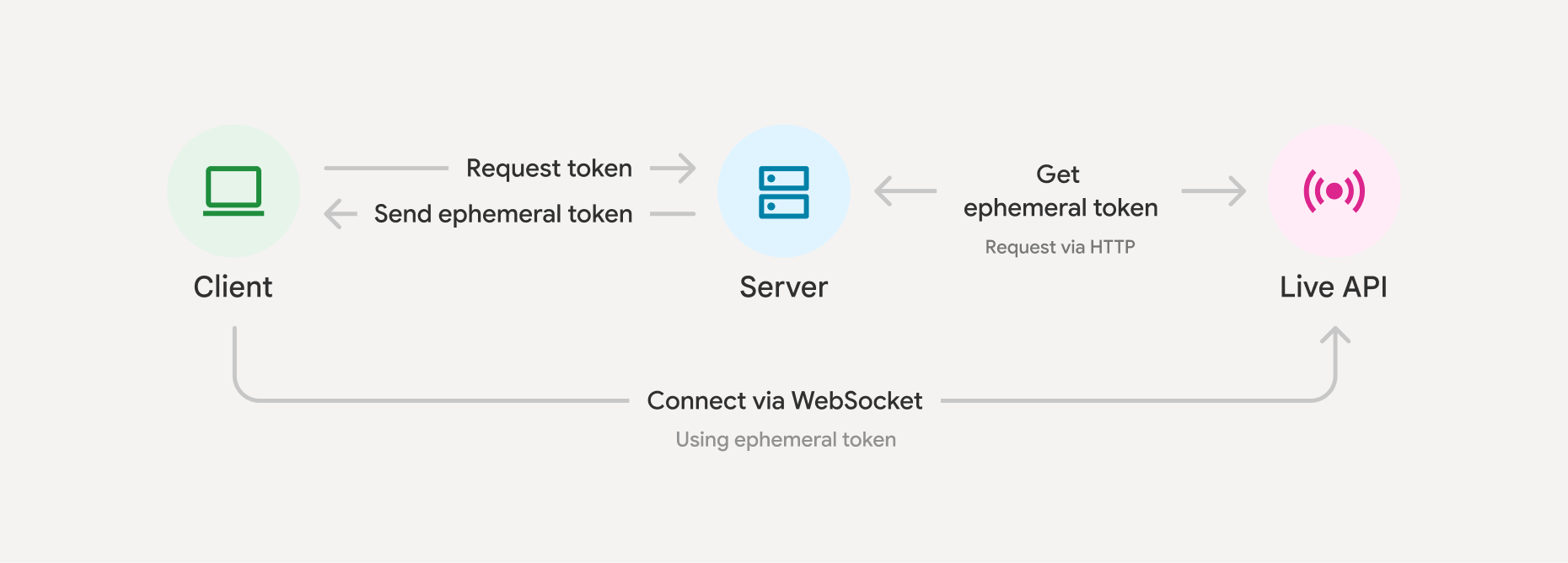אסימונים זמניים הם אסימוני אימות לטווח קצר שמאפשרים גישה ל-Gemini API דרך WebSockets. הם נועדו לשפר את האבטחה כשמתחברים ישירות ממכשיר של משתמש ל-API (הטמעה של לקוח לשרת). בדומה למפתחות API רגילים, אפשר לחלץ טוקנים זמניים מאפליקציות בצד הלקוח, כמו דפדפני אינטרנט או אפליקציות לנייד. אבל מכיוון שתוקף האסימונים הזמניים פג במהירות ואפשר להגביל אותם, הם מפחיתים באופן משמעותי את סיכוני האבטחה בסביבת ייצור. מומלץ להשתמש בהם כשניגשים ישירות ל-Live API מאפליקציות בצד הלקוח, כדי לשפר את האבטחה של מפתחות ה-API.
איך פועלים טוקנים זמניים
כך פועלים טוקנים זמניים ברמה גבוהה:
- הלקוח (לדוגמה, אפליקציית אינטרנט) עובר אימות עם ה-Backend.
- הבקשות של ה-backend מקבלות טוקן זמני משירות ההקצאה של Gemini API.
- Gemini API מנפיק אסימון לטווח קצר.
- הקצה העורפי שולח את האסימון ללקוח לחיבורי WebSocket ל-Live API. כדי לעשות את זה, מחליפים את מפתח ה-API באסימון זמני.
- לאחר מכן הלקוח משתמש באסימון כאילו היה מפתח API.

השימוש באסימון משפר את האבטחה, כי גם אם הוא נשלף, תוקף האסימון קצר, בניגוד למפתח API לטווח ארוך שמוטמע בצד הלקוח. מכיוון שהלקוח שולח נתונים ישירות ל-Gemini, זה גם משפר את זמן האחזור ומונע את הצורך בשרתי קצה עורפיים (back-end) שיפעלו כשרתי proxy לנתונים בזמן אמת.
יצירת טוקן זמני
הנה דוגמה פשוטה שמראה איך לקבל מ-Gemini טוקן זמני.
כברירת מחדל, יש לכם דקה אחת להתחיל סשנים חדשים של Live API באמצעות הטוקן מהבקשה הזו (newSessionExpireTime), ו-30 דקות לשלוח הודעות דרך החיבור הזה (expireTime).
Python
import datetime
now = datetime.datetime.now(tz=datetime.timezone.utc)
client = genai.Client(
http_options={'api_version': 'v1alpha',}
)
token = client.auth_tokens.create(
config = {
'uses': 1, # The ephemeral token can only be used to start a single session
'expire_time': now + datetime.timedelta(minutes=30), # Default is 30 minutes in the future
# 'expire_time': '2025-05-17T00:00:00Z', # Accepts isoformat.
'new_session_expire_time': now + datetime.timedelta(minutes=1), # Default 1 minute in the future
'http_options': {'api_version': 'v1alpha'},
}
)
# You'll need to pass the value under token.name back to your client to use it
JavaScript
import { GoogleGenAI } from "@google/genai";
const client = new GoogleGenAI({});
const expireTime = new Date(Date.now() + 30 * 60 * 1000).toISOString();
const token: AuthToken = await client.authTokens.create({
config: {
uses: 1, // The default
expireTime: expireTime // Default is 30 mins
newSessionExpireTime: new Date(Date.now() + (1 * 60 * 1000)), // Default 1 minute in the future
httpOptions: {apiVersion: 'v1alpha'},
},
});
למידע על אילוצים, ערכי ברירת מחדל ומפרטים אחרים של השדה expireTime, אפשר לעיין בהפניית ה-API.
במהלך expireTime הזמן הזה, תצטרכו sessionResumption להתחבר מחדש לשיחה כל 10 דקות (אפשר לעשות את זה עם אותו אסימון גם אם uses: 1).
אפשר גם לנעול טוקן זמני לקבוצה של הגדרות. האפשרות הזו יכולה להיות שימושית לשיפור נוסף של האבטחה באפליקציה ולשמירה על הוראות המערכת בצד השרת.
Python
client = genai.Client(
http_options={'api_version': 'v1alpha',}
)
token = client.auth_tokens.create(
config = {
'uses': 1,
'live_connect_constraints': {
'model': 'gemini-2.5-flash-native-audio-preview-12-2025',
'config': {
'session_resumption':{},
'temperature':0.7,
'response_modalities':['AUDIO']
}
},
'http_options': {'api_version': 'v1alpha'},
}
)
# You'll need to pass the value under token.name back to your client to use it
JavaScript
import { GoogleGenAI } from "@google/genai";
const client = new GoogleGenAI({});
const expireTime = new Date(Date.now() + 30 * 60 * 1000).toISOString();
const token = await client.authTokens.create({
config: {
uses: 1, // The default
expireTime: expireTime,
liveConnectConstraints: {
model: 'gemini-2.5-flash-native-audio-preview-12-2025',
config: {
sessionResumption: {},
temperature: 0.7,
responseModalities: ['AUDIO']
}
},
httpOptions: {
apiVersion: 'v1alpha'
}
}
});
// You'll need to pass the value under token.name back to your client to use it
אפשר גם לנעול קבוצת משנה של שדות. מידע נוסף זמין במסמכי התיעוד של ה-SDK.
התחברות ל-Live API באמצעות טוקן זמני
אחרי שמקבלים אסימון זמני, משתמשים בו כאילו היה מפתח API (אבל חשוב לזכור שהוא פועל רק עם ה-API הפעיל, ורק עם גרסה v1alpha של ה-API).
השימוש בטוקנים זמניים מוסיף ערך רק כשפורסים אפליקציות שפועלות לפי גישת הטמעה מלקוח לשרת.
JavaScript
import { GoogleGenAI, Modality } from '@google/genai';
// Use the token generated in the "Create an ephemeral token" section here
const ai = new GoogleGenAI({
apiKey: token.name
});
const model = 'gemini-2.5-flash-native-audio-preview-12-2025';
const config = { responseModalities: [Modality.AUDIO] };
async function main() {
const session = await ai.live.connect({
model: model,
config: config,
callbacks: { ... },
});
// Send content...
session.close();
}
main();
דוגמאות נוספות מופיעות במאמר תחילת העבודה עם Live API.
שיטות מומלצות
- מגדירים משך תפוגה קצר באמצעות הפרמטר
expire_time. - תוקף האסימונים פג, ולכן צריך להפעיל מחדש את תהליך ההקצאה.
- צריך לאמת אימות מאובטח לשרת העורפי שלכם. האבטחה של טוקנים זמניים תהיה זהה לשיטת האימות של ה-Backend.
- בדרך כלל, מומלץ להימנע משימוש בטוקנים זמניים לחיבורים בין קצה העורפי ל-Gemini, כי הנתיב הזה נחשב בדרך כלל למאובטח.
מגבלות
בשלב הזה, טוקנים זמניים תואמים רק ל-Live API.
המאמרים הבאים
- מידע נוסף זמין בהפניה ל-Live API בנושא אסימונים זמניים.

